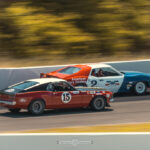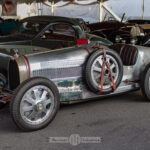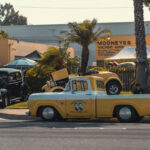
Event Report – Radwood LA 2018 Part 2: Revolution
We’ll always pine away for cars we idolized when we were young. The speed machine that hung on our childhood bedroom wall burns into our retinas and influences our taste in a way that no newcomer can quite outshine. That nostalgia has had a clear effect on the classic car market since cars have been old enough to be considered classics. The Rad era cars are only the latest vehicles once perceived as ex-beaters and out-of-date status symbols to raise eyebrows and checkbooks at auction as a new generation comes into the market.

Nostalgia isn’t the only reason that classic cars gain value. There are makes, models, and eras that are transformative to the automotive standard or the world at large. In the 1920s and 1930s the car matured past being a science experiment, motorsport became the juggernaut sport it is to this day, and rural communities gained a transformative mobility. In the late 1950s and 1960s cars took another leap in performance, spawned some of the most iconic models and dynasties, and physically remapped our towns and cities by creating suburbs and sprawl. The cars that led these tentpole eras in automotive design continue to be idols and are valued accordingly.
The exploding appreciation for Radwood cars isn’t solely based on wealthy millenials and Gen Xers looking to blow their new paychecks on reliving the old glory days. I believe the late ’80s and ’90s are going to be one of those amazing and iconic eras.

Each of the influential eras of automotive engineering have funneled a disparate collection of unoptimized solutions into a standard set of technologies with the potential to motivate us for decades to come. In hindsight, the cars before World War 1 were the whackiest designs imaginable and often toys for the rich. Innovation and imagination were all that many early pioneers had to go on. After the war and into the 1930s the wheat was separated from the chaff on both the assembly lines of industry and finish lines of motorsport. What remained were efficient and powerful automobiles that had fully shed their horsedrawn ancestory. In the 1950s and 1960s, America nearly perfected the automatic transmission and push rod V8 while the small FWD layout exploded in popularity in Europe and Japan with game changers like the Mini Cooper and Citroen 2CV, among many other engineering marvels.
This transition repeats in the rad era. By the 1970s the car was suffering from its own popularity. The realities of air pollution and ensuing regulations turned the mighty V8 into an anemic and strangled shadow of itself. Fuel was controlled with rudimentary mechanical fuel injection systems or carburetors mired in a swamp of vacuum lines and actuators. European and Japanese small engines faired better but weren’t at risk of setting any speed records and were running out of room for optimization within their simple designs.
Then two technologies straight out of science fiction hit the internal combustion engine like a lightning bolt and put hair-raising performance back on the menu: electronic fuel injection and turbocharging. Neither were new; the former was invented by General Motors in the early 1970s and the latter was a competitive aircraft technology during World War 2. But to the regular consumer car or even supercars of the day they were like phasers and starships. Through the ’70s, ’80s, and ’90s the turbo became a symbol of power as it trickled from exotic endurance race cars, to fire-breathing rally cars, to supercars, and eventually into showroom stars like the Buick GNX, Saab 99 Turbo, and the Porsche 911 Turbo. EFI could extract both performance and efficiency from forced induction with its myriad of compensations and adjustments in a way that carburetors had failed to in previous decades. The benefits weren’t limited to performance and soon even modest commuter cars were achieving unheard of economy and performance with a microcontroller under the hood. A turbocharger offered performance and intimidation that had once been reserved for a big block idling up on a lopey cam.
If the technology inside or performance potential didn’t differentiate cars from previous decades new styling was inescapable to even the casual observer. Lee Iacocco famously told a young Chrysler exectuive named Bob Lutz that his lack of interest in landau tops and opera windows would reverse as he grew older. But just like Chrysler themselves had broken the cycle of car design in 1957 with the revolutionary Forward Look and Iaccoco had electrified the youth with the Mustang in the 1960s the rules were being rewritten once again. The digital age brought angularity and futurism back into the automobile. The Corvette began 1980 with a blatantly ’70s design that had been warmed over to cling to relevance. By the mid 1990s it was lower, sleeker, and had a shape that would carry the icon through the next two decades. The hatchback segment in the US had struggled to beat a stigma of compromise and cheapness but snarling Group B rally cars and playful commuters like the Volkswagen GTI soon shifted the public perception. By the end of the era the hot hatch had become something of a muscle car analogue; a capable sports car with humble daily driver origins and hotrod parts.
Pages could be wasted listing all of the transformative and iconic automobiles from the 1980s and 1990s (though pages more would be required to list all of the exceptions). Maybe you fondly remember the glory days of Radwood cars or you might be wondering why everyone gets so excited about those plastic-y econoboxes. The nostalgia isn’t the only reason appreciation for the era is growing. It was yet another groundbreaking time of change and innovation with consequences for decades to follow. If you’re still dubious, you should get used to them now because the best cars from the 1980s and 1990s will be in museums, car shows, and concours for decades to come.















